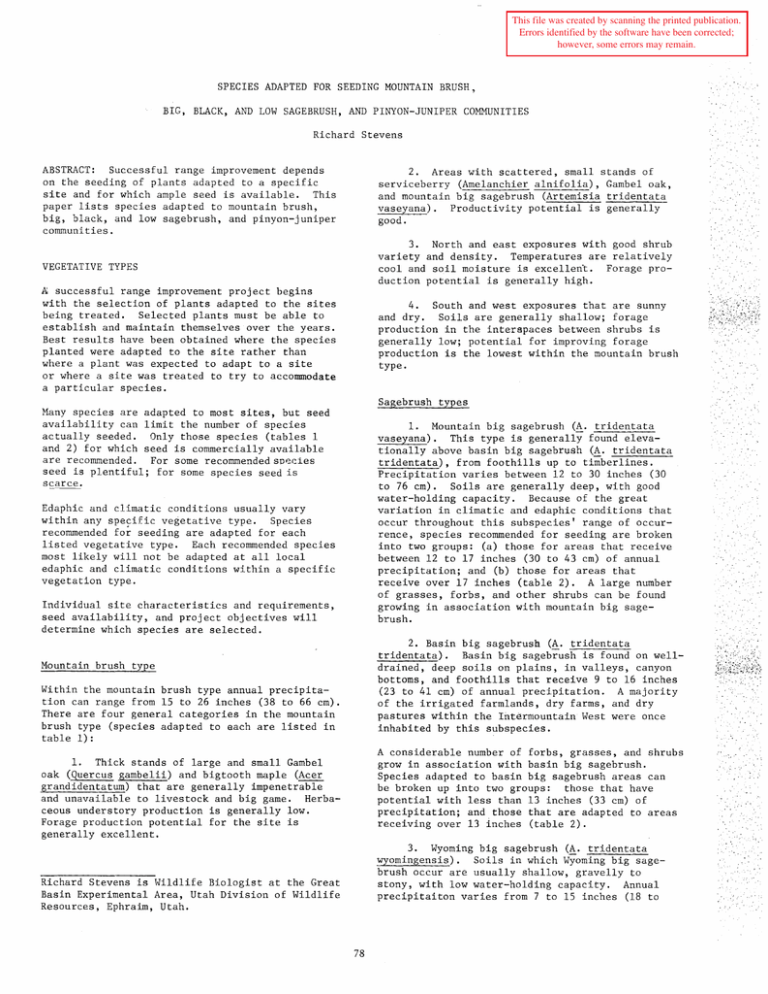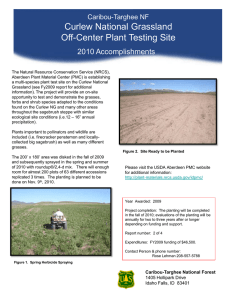SPECIES ADAPTED FOR SEEDING MOUNTAIN ... BIG, BLACK, AND LOW SAGEBRUSH, ...
advertisement

This file was created by scanning the printed publication. Errors identified by the software have been corrected; however, some errors may remain. SPECIES ADAPTED FOR SEEDING MOUNTAIN BRUSH, BIG, BLACK, AND LOW SAGEBRUSH, AND PINYON-JUNIPER COMMUNITIES Richard Stevens ABSTRACT: Successful range improvement depends on the seeding of plants adapted to a specific site and for which ample seed is available. This paper lists species adapted to mountain brush, big, black, and low sagebrush, and pinyon-juniper communities. 2. Areas with scattered, small stands of serviceberry (Amelanchier alnifolia), Gambel oak, and mountain big sagebrush (Artemisia tridentata vaseyana). Productivity potential is generally good. VEGETATIVE TYPES 3. North and east exposures with good shrub variety and density. Temperatures are relatively cool and soil moisture is excellen~. Forage production potential is generally high. successful range improvement project begins with the selection of plants adapted to the sites being treated. Selected plants must be able to establish and maintain themselves over the years. Best results have been obtained where the species planted were adapted to the site rather than where a plant was expected to adapt to a site or where a site was treated to try to accommodate a particular species. 4. South and west exposures that are sunny and dry. Soils are generally shallow; forage production in the interspaces between shrubs is generally low; potential for improving forage production is the lowest within the mountain brush type. ~ Sagebrush types Many species are adapted to most sites, but seed availability can limit the number of species actually seeded. Only those species (tables 1 and 2) for which seed is commercially available are recommended. For some recommended species seed is plentiful; for some species seed is scarce. 1. Mountain big sagebrush (!. tridentata vaseyana). This type is generally found elevationally above basin big sagebrush (!. tridentata tridentata), from foothills up to timberlines. Precipitation varies between 12 to 30 inches (30 to 76 em). Soils are generally deep, with good water-holding capacity. Because of the great variation in climatic and edaphic conditions that occur throughout this subspecies' range of occurrence, species recommended for seeding are broken into two groups: (a) those for areas that receive between 12 to 17 inches (30 to 43 em) of annual precipitation; and (b) those for areas that receive over 17 inches (table 2). A large number of grasses, forbs, and other shrubs can be found growing in association with mountain big sagebrush. Edaphic and climatic conditions usually vary within any specific vegetative type. Species recommended fo~ seeding are adapted for each listed vegetative type. Each recommended species most likely will not be adapted at all local edaphic and climatic conditions within a specific vegetation type. Individual site characteristics and requirements, seed availability, and project objectives will determine which species are selected. 2. Basin big sagebrush (A. tridentata tridentata). Basin big sagebrush is found on welldrained, deep soils on plains, in valleys, canyon bottoms, and foothills that receive 9 to 16 inches (23 to 41 em) of annual precipitation. A majority of the irrigated farmlands, dry farms, and dry pastures within the Intermountain West were once inhabited by this subspecies. Mountain brush type Within the mountain brush type annual precipitation can range from 15 to 26 inches (38 to 66 em). There are four general categories in the mountain brush type (species adapted to each are listed in table 1): A considerable number of forbs, grasses, and shrubs grow in association with basin big sagebrush. Species adapted to basin big sagebrush areas can be broken up into two groups: those that have potential with less than 13 inches (33 em) of precipitation; and those that are adapted to areas receiving over 13 inches (table 2). 1. Thick stands of large and small Gambel oak (Quercus gambelii) and bigtooth maple (Acer grandidentatum) that are generally impenetrable and unavailable to livestock and big game. Herbaceous understory production is generally low. Forage production potential for the site is generally excellent. 3. Wyoming big sagebrush (A. tridentata wyomingensis). Soils in which Wyoming big sagebrush occur are usually shallow, gravelly to stony, with low water-holding capacity. Annual precipitaiton varies from 7 to 15 inches (18 to Richard Stevens is Wildlife Biologist at the Great Basin Experimental Area, Utah Division of Wildlife Resources, Ephraim, Utah. 78 Table 1. -- Species adapted to the mountain brush types in the Intermountain West Exposure Community type North Southwest Open Closed and (Sunny & (Oak and (Oak and East dry). serviceberry) maple) Species GRASSES AND FORBS: Brame, Regar Brame, smooth (southern) Fescue, hard sheep Needlegrass, green Oatgrass, tall Orchardgrass Wheatgrass, bluebunch Wheatgrass, crested Wheatgrass, fairway Wheatgrass, intermediate Wildrye, Great Basin Wildrye, Russian Bluegrass, Kentucky Alfalfa (Nomad, Ladak, Rambler), spreading strains Balsamroot, arrowleaf Balsamroot, curlleaf Burnet, small Crownvetch Flax, Lewis Goldeneye, showy Lomatium, Nuttall Lupine, silky Milkvetch, chickpea Penstemon, low Penstemon, Palmer Penstemon, Rocky Mountain Sainfoin Sweetanise . Sweetclover, yellow Sweetvetch, Utah Sunflower, oneflower Bromus biebersteinii Bromus inermis ~a ovina ~uriuscula Stipa viridula Arrhenatherum elatius Dactylis glomerata Agropyron spicatum Agropyron desertorum Agropyron cristatum Agropyron intermedium Elymus cinereus ~ junceus Poa pratensis X Medicago sativa Balsamorhiza sagittata Balsamorhiza macrophylla Sanguisorba minor Coronilla varia Linum lewi~ Viguiera multiflora Lomatium nuttallii Lupinus sericeus Astragalus cicer Penstemon humilus Penstemon palmerii Penstemon strictus Onobrychis viciaefolia Osmorhiza occidentalis Melilotus officinalis Hedysarum boreale utahensis Helianthella annus X X X X X X X X X X X X X X X X X X X X X X X X X X X X X X X X X X X X X X X X X X X X X X X X X X X X X X X X X X X X X X X X X X X X X X X X X X X X X X X X X X X X X X X X X X X X X X X X SHRUBS: Bitterbrush, antelope Chokecherry, black Elder, blueberry Ephedra, green Mountain mahogany, curlleaf Mountain mahogany, true Rabbitbrush, mountain rubber Sagebrush, big mountain Serviceberry, Saskatoon Serviceberry, Utah Sqawapple Purshia tridentata Prunus virginiana melanocarpa Sambucus cerulea Ephedra viridis Cercocarpus ledifolius ledifolius Cercocarpus montanus Chrysothamnus nauseosus salicifolius Artemisia tridentata vaseyana Amelanchier alnifolia Amelanchier utahensis Peraphyllum ramosissimum X X X X X X X X X X 38 em). Generally, few herbaceous species are found growing in association with Wyoming big sagebrush. Likewise, few species are adapted for which seed is available (table 2). rocky, and well drained, with poor moisture-holding capacity. Few grasses, forbs or shrubs for which seed is available are adapted to areas in which black sagebrush is dominant (table 2). 4. Black sagebrush (!. nova). Annual precipitation throughout the area in which black sagebrush occurs varies between 7 and 18 inches (18 and 46 em). Soils are generally shallow, 5. Low sagebrush(!. arbuscula). Low sagebrush grows on dry, sterile, rocky, often alkaline soils that range from shallow to moderately deep. Hardpans, 10 to 15 inches (25 to 38 em) deep are 79 Table 2. -- Species adapted to sagebrush communities in the Intermountain West. Mountain big sagebrush Species (12-17) (17+) Basin big sagebrush Wyoming sagebrush Black sagebrush Low sagebrush (9-13) (13+) Inches 1 Inches GRASSES: Alkali sacaton, Sporobolus airoides Regar brome, Bromus biebersteinii Smooth brome, Bromus inermis (southern) Hard sheep fescue, Festuca ovina duriuscula ----Sulcate sheep fescue, Festuca ovina sulcata Needle-and-thread, Stipa comata Tall oatgrass, Arrhenatherum elatius Orchardgrass, Dactylis glomerta Indian ricegrass, Oryzopsis hymenoides Bottlebrush squirreltail, Sitanion hystrix Bluebunch wheatgrass, Agropyron spicatum Bluebunch, beardless wheatgrass, Agropyron inerme Crested wheatgrass, Agropyron desertorum Fairway wheatgrass, Agropyron cristatum Intermediate wheatgrass, Agropyron intermedium Pubescent wheatgrass, Agropyron trichophorum Siberian wheatgrass, Agropyron sibiricum Slender wheatgrass, Agropyron trachycaulum Tall wheatgrass, Agropyron elongatum Thickspike wheatgrass, Agropyron dasystachyum Great Basin wildrye, Elymus cinereus Russian wildrye, Elymus junceus X X X X X X X X X X X X X X X X X X X X X X X X X X X X X X X X X X X X X X X X X X X X X X X X X X X X X X X X X X X X X X X X X X X X X X X X X X X X X X X X X X X X X X X X FORBS: Ladak, Nomad, spreading strains-Alfalfa Medicago sativa Arrowleaf balsamroot, Balsamorhiza sagittata Cutleaf balsamroot, Balsamorhiza macrophylla Small burnet, Sanguisorba minor Crownvetch, Coronilla varia Lewis flax, Linum lewisii Showy goldeneye, Viguiera multiflora Gooseberryleaf globemallow, Sphaeralcea grossulariaefolia Scarlet globemallow, Sphaeralcea coccinea Nuttall lomatium, Lomatium nuttallii Mountain lupine, Lupinus alpestris Silky lupine, Lupinus sericeus Silvery lupine, Lupinus argenteus Chickpea milkvetch, Astragalus cicer Low penstemon, Penstemon humilus Palmer penstemon, Penstemon palmeri Rocky Mountain penstemon, Penstemon strictus Sainfoin, Onobrychis viciaefolia Sweetanise, Osmorhiza occidentalis Yellow sweetclover, Melilotus officinalis Utah sweetvetch, Hedysarum boreale utahensis Oneflower sunflower, Helianthella annus X X X X X X X X X X X X X X X X X X X X X X X X X X X X X X X X X X X X X X X X X X X X X X X X X X X X X X X X X X X X X X X X X X (con.) 80 Table 2. -- (con.) Species Mountain big sagebrush ( 12-1 7) ( 17 +) 1 Inches Basin big Wyoming sagebrush sagebrush (9-13) (13+) Black sagebrush Low sagebrush 1 Inches SHRUBS: Antelope bitterbrush, Purshia tridentata Black chokecherry, Prunus virginiana melanocarpa Stansbury cliffrose, Cowania mexicana stansburiana Blueberry elder, Sambucus cerulea Green ephedra, Ephedra viridis Nevada ephedra, Ephedra nevadensis Prostrate kochia, Kochia prostrata True mountain mahogany, Cercocarpus montanus Curlleaf mountain mahogany, Cercocarpus ledifolius Hairy low rabbitbrush, Chrysothamnus viscidiflorus puberulus Mountain rabbitbrush, Chrysothamnus viscidiflorus lanceolatus Mountain rubber rabbitbrush, Chrysothamnus nauseosus salicifolius ~fuite rubber rabbitbrush, Chrysothamnus nauseosus albicaulis Basin big sagebrush, Artemisia tridentata tridentata Mountain big sagebrush, Artemisia tridentata vaseyana Wyoming big sa~ebrush, ·Artemisia tridentata wyomingensis Black sagebrush, Artemisia nova Low sagebrush, Artemisia arbuscula Fourwing saltbush, Atriplex ~anescens Saskatoon serviceberry, Amelanchier alnifolia Winterfat, Ceratoides lanata X X X X X X X X X X X X X X X X X X X X X X X X X X X X X X X X X X X X X X X X X X X X X X X X X X X X X X X X X X X X X X X X 1 Annual precipitation. 2With more than 12 inches (30 em) annual precipitation. 81 not uncommon. Annual precipitation varies between 7 and 18 inches (18 and 46 em). Pinyon-Juniper Type This type is widespread throughout the Intermountain West. Pinyon or juniper (or both) can be found in all sagebrush types. Where pinyon or juniper is dominant, sagebrush can be found in small or large quantities. The species adapted to a particular pinyonjuniper site are indicated by the sagebrush present. Species adapted to the sagebrush type (table 2) associated with the pinyon-juniper should be adapted to the site. 82






